German church finally apologises for witch burning after 400 years of silence
Around 60,000 innocent people were killed in Europe between the 15th and 18th centuries, accused of being witches

In the Bavarian city of Eichstätt, between the 15th and 18th centuries, around 400 innocent people were tortured and killed on the grounds that they were witches.
Those persecuting the so-called witches, even had their own ways of deciding whether or not the accused was innocent.
Local tests included “helmet cutting” where a spiky metal band was tightened around the victim’s head.
In the time of witch hunting, around 60,000 people were killed in Europe. This included about 25,000 in German lands. The victims were mostly women but some men and children also suffered.
The Catholic church in Eichstätt has kept its mouth quite firmly shut on the matter for 400 or so years. But now, the town’s bishop, Gregor Maria Hanke has promised a memorial plaque in the local cathedral. The bishop described the events as a “bleeding wound in the history of our church,” a statement that campaigners had been waiting to hear after years of calling on churches to admit their guilt.
An artist from Munich, Wolfram Kastner who has been credited with the Eichstätt diocese’s examination of its past said: “It’s good that they’ve done something but of course it’s not nearly enough.”
Mr Kastner started his campaign in 2017, when he discovered the original interrogation transcripts in Eichstätt. The artist was so shocked that he decided to draw attention to what had happened.
As part of his campaign he read out the fates of the victims in the square outside the town’s cathedral.
One example, from 1627, is that of Ursula Bonschab who was the mayor’s wife. Aged 36, she was arrested and tortured for 20 days.
Finally Ms Bonschab confessed to the charges which included digging up corpses of dead children, fornicating with the devil and poisoning others. As a result she was burnt at the stake but avoided being decapitated first.
Witch trials were traditionally run by courts which were not directly linked to the church but those who campaign say that the church is to blame. This is because doctrine about witches and the devil was used when accusing the innocent of crimes.
A campaign began in 2011 and was started by a retired German pastor, Hartmut Hegeler. In the nine years since it began, over 50 towns have apologised for the part they had to play in witch burning.
Mr Hegeler told The Times newspaper: “The church was scared of the Reformation and the witch trials were a means to combat it.”
He added that those who turned away from Catholicism were “labelled as being in a league with the devil” and it worked.
Join our commenting forum
Join thought-provoking conversations, follow other Independent readers and see their replies
Comments


Bookmark popover
Removed from bookmarks